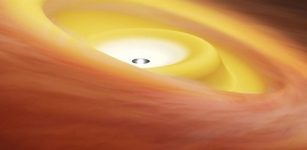Enceladus: Inner Complexity Of Saturn Moon Fascinates
Eddie Gonzales Jr. – MessageToEagle.com – Enceladus, the sixth moon of Saturn is a fascinating, celestial object. It’s a small ocean world covered in ice — one of more than 60 confirmed moons orbiting Saturn.
 Using new geochemical models, SwRI scientists found that CO2 in Enceladus’ ocean may be controlled by chemical reactions at the seafloor. Integrating this finding with previous discoveries of H2 and silica suggests geochemically diverse environments in the rocky core. This diversity has the potential to create energy sources that could support life. Courtesy of NASA/JPL-Caltech
Using new geochemical models, SwRI scientists found that CO2 in Enceladus’ ocean may be controlled by chemical reactions at the seafloor. Integrating this finding with previous discoveries of H2 and silica suggests geochemically diverse environments in the rocky core. This diversity has the potential to create energy sources that could support life. Courtesy of NASA/JPL-Caltech
It’s 25 times smaller than Earth and almost 10 times as far from the sun, yet in recent years, it’s given scientists many reasons to think it should be the next target in our search for worlds where extraterrestrial life could exist.
Now, astronomers from Southwest Research Institute developed a new geochemical model that reveals that carbon dioxide (CO2) from within Enceladus, an ocean-harboring moon of Saturn, may be controlled by chemical reactions at its seafloor.
The team studied the plume of gases and frozen sea spray released through cracks in the moon’s icy surface suggests an interior more complex than previously thought.
“By understanding the composition of the plume, we can learn about what the ocean is like, how it got to be this way and whether it provides environments where life as we know it could survive,” SwRI’s Dr. Christopher Glein, lead author of a paper, said in a press release.
“We came up with a new technique for analyzing the plume composition to estimate the concentration of dissolved CO2 in the ocean. This enabled modeling to probe deeper interior processes.”
See also:
Enceladus’ Core Could Be Heating Water In Ocean Of Saturn’s Moon
Organic Molecules Are Ejected From Cracks In Surface Of Saturn’s Moon Enceladus
Gases In Enceladus’ Subsurface Ocean Possibly Provide Conditions Favorable To Life
Enceladus’ ‘Tiger Stripes’ – Astronomers Know What Causes Them
Discovered on August 28, 1789, by William Herschel, Enceladus was little was known, until the two Voyager spacecraft, Voyager 1 and Voyager 2, passed nearby in the early 1980s. In 2005, the Cassini spacecraft started multiple close flybys of Enceladus, revealing its surface and environment in greater detail. In particular, Cassini discovered water-rich plumes venting from the south polar region.
There are still several benefits of Cassini’s close flyby of Enceladus on Oct. 28, 2015, prior to the end of the mission.
 Enceladus Ice Volcanos – Illustration Credit & Copyright: Michael Carroll
Enceladus Ice Volcanos – Illustration Credit & Copyright: Michael Carroll
Analysis of mass spectrometry data from NASA’s Cassini spacecraft indicates that the abundance of CO2 is best explained by geochemical reactions between the moon’s rocky core and liquid water from its subsurface ocean. Integrating this information with previous discoveries of silica and molecular hydrogen (H2) points to a more complex, geochemically diverse core.
“Based on our findings, Enceladus appears to demonstrate a massive carbon sequestration experiment,” Glein said.
“On Earth, climate scientists are exploring whether a similar process can be utilized to mitigate industrial emissions of CO2. Using two different data sets, we derived CO2 concentration ranges that are intriguingly similar to what would be expected from the dissolution and formation of certain mixtures of silicon- and carbon-bearing minerals at the seafloor.”
The likely presence of hydrothermal vents inside Enceladus is another phenomenon that contributes to the complexity of this moon. At Earth’s ocean floor, hydrothermal vents emit hot, energy-rich, mineral-laden fluids that allow unique ecosystems teeming with unusual creatures to thrive.
INMS detected H2 as the spacecraft flew through the plume, and a different instrument had earlier detected tiny particles of silica, two chemicals that are considered to be markers for hydrothermal processes.
“Distinct sources of observed CO2, silica and H2 imply mineralogically and thermally diverse environments in a heterogeneous rocky core,” Glein said. “We suggest that the core is composed of a carbonated upper layer and a serpentinized interior.” Carbonates commonly occur as sedimentary rocks such as limestone on Earth, while serpentine minerals are formed from igneous seafloor rocks that are rich in magnesium and iron.
Written by Eddie Gonzales Jr. – MessageToEagle.com Staff










